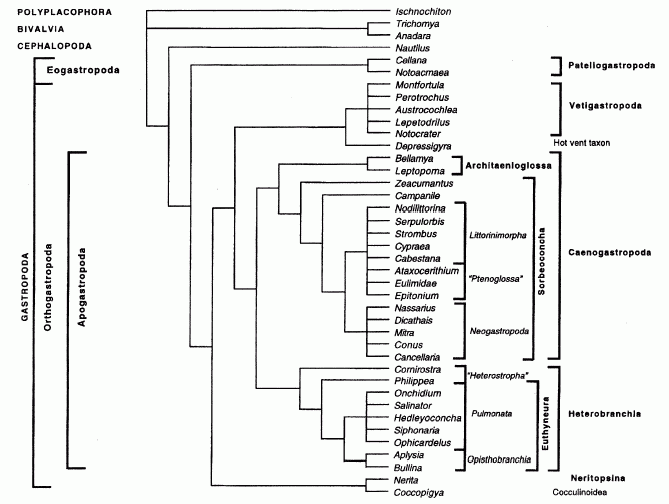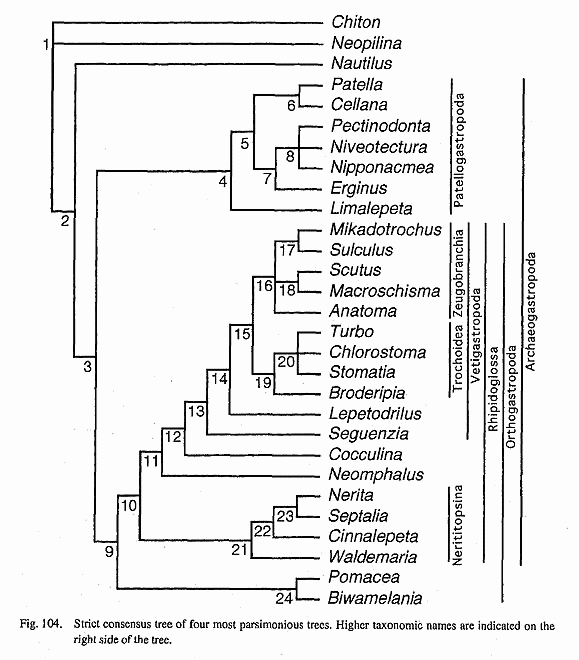| Gastropoda | ||
| Mollusca | Systematics |
Conchifera
└─► |
|||
◄═╤═Eogastropoda (paraphyletic or polyphyletic)
└─Orthogastropoda |
|
Abbreviated Dendrogram
Mollusca
├─Aculifera
└─Conchifera
╘═Helcionelloida
└─┬─Bellerophontoidea
└─Gastropoda (crown group)
╞═Eogastropoda (paraphyletic or polyphyletic)
│ ├?─Macluritoidea
│ ├?─Euomphaloidea
│ └─Patellogastropoda
└─Orthogastropoda
├─Vetigastropoda
├─Neritimorpha
└─┬─Caenogastropoda
└─Heterobranchia
├─Opisthobranchia
└─Pulmonata
|
Contents
Index |
While there were a number of 19th century studies of gastropod relationships using fossil taxa, a consensus view about gastropod phylogeny - based on both fossil and extant forms (i.e. paleontology and neontology) - did not develop until the early 20th century, (e.g., Wenz, 1938; see also Knight, et al., 1960) and this continued basically until the 1980s. In this interpretation, Gastropods were classified into either two or three subclasses - the Prosobranchia or Streptoneura (mostly marine, torted (so the nervous system is twisted in a figure-8 shape and the gills are in front of the heart), the Opisthobranchia (marine, detorted with a single gill behind the heart, internal or absent shell), and Pulmonata (also detorted, lungs instead of gills, freshwater or terrestrial), the latter two also being grouped together as the subclass Euthyneura, having undergo detorsion and regained bilateral symmetry. The Prosobranchia in turn have been divided into Archaeogastropoda (most primitive, including many Palaeozoic types), Mesogastropoda, and Neogastropoda (most advanced types); the latter two groups being combined as the Caenogastropoda. It was assumed that Pleurotomarioid Archaeogastropods are the most primitive living group, these having arose from bilaterally symmetrical bellerophontid ancestors and were barely changed since the Paleozoic. As well as the Pleurotomarioidea, the archaeogastropods included Patelloidea, Neritoidea, and Trochoidea, as well as the extinct Bellerophontoidea and Euomphaloidea/Macluritoidea. With the exception of the latter superfamily/suborder, fossil taxa either were lumped into modern groups (e.g., the Platyceratoidea with the Trochoidea) or were considered their ancestors (e.g., the Loxonematoidea relative to Caenogastropods and the Subulitoidea relative to neogastropods [Knight, et al., 1960].
In the last couple of decades however, the discovery of completely new groups, such as deep water hot-vent (the "black smokers") taxa, along with adoption of a neontological (and later paleontological) cladistic analysis, led to radical revisions in the tidy three-fold schema [Wagner 2001]. Phylogenetic analyses of extant groups have showed that many of these taxa diverged early in gastropod history [Haszprunar 1988; Ponder and Lindberg, 1997; Sasaki, 1998; Colgan, et al., 2000], while study of fossil taxa shows that many Paleozoic species attributed to the Pleurotomarioidea and the Trochoidea are actually polyphyletic assemblages derived from euomphalid and murchisoniid gastropods, and other groups like the Bellerophontoidea, Euomphaloidea, and Subulitoidea are likewise polyphyletic [Wagner 1999, 2001]
While the old three-fold classification can still be found in many books, it is no longer consider valid by many workers in this field. The Prosobranchia and Archaeogastropoda have been shown to be simply grades united by shared primitive characteristics. In addition they include such a diverse range of gastropod groups as to be almost meaningless. The Mesogastropoda taxon also has been rejected; first divided into two distinct groups, the Architaenoglossa (being more primitive), and the Neotaenioglossa [Haszprunar 1988], and then the Neotaenioglossa shown to be paraphyletic (since some forms gave rise to the Neogastropoda) [Ponder and Lindberg, 1997], and it is speculated that the Opisthobranchia may be likewise, having given rise to the Pulmonata [Colgan, et al., 2000], although evidence is still somewhat controversial on this point.
The following cladogram by Ponder and Lindberg 1997 represents the most popular current hypothesis of gastropod relationships.

Independent analysis by Sasaki, 1998 of the Archaeogastropoda alone came up with a very similar picture.

It should be noted however that molecular evidence does not seem to support the monophyly of the Eogastropoda [Colgan, Ponder, & Eggler 2000], even if other cladistic analysis does. So even these diagrams may warrant revision and modification.
page uploaded 22 December 2002
checked ATW051004